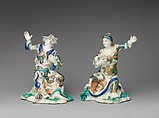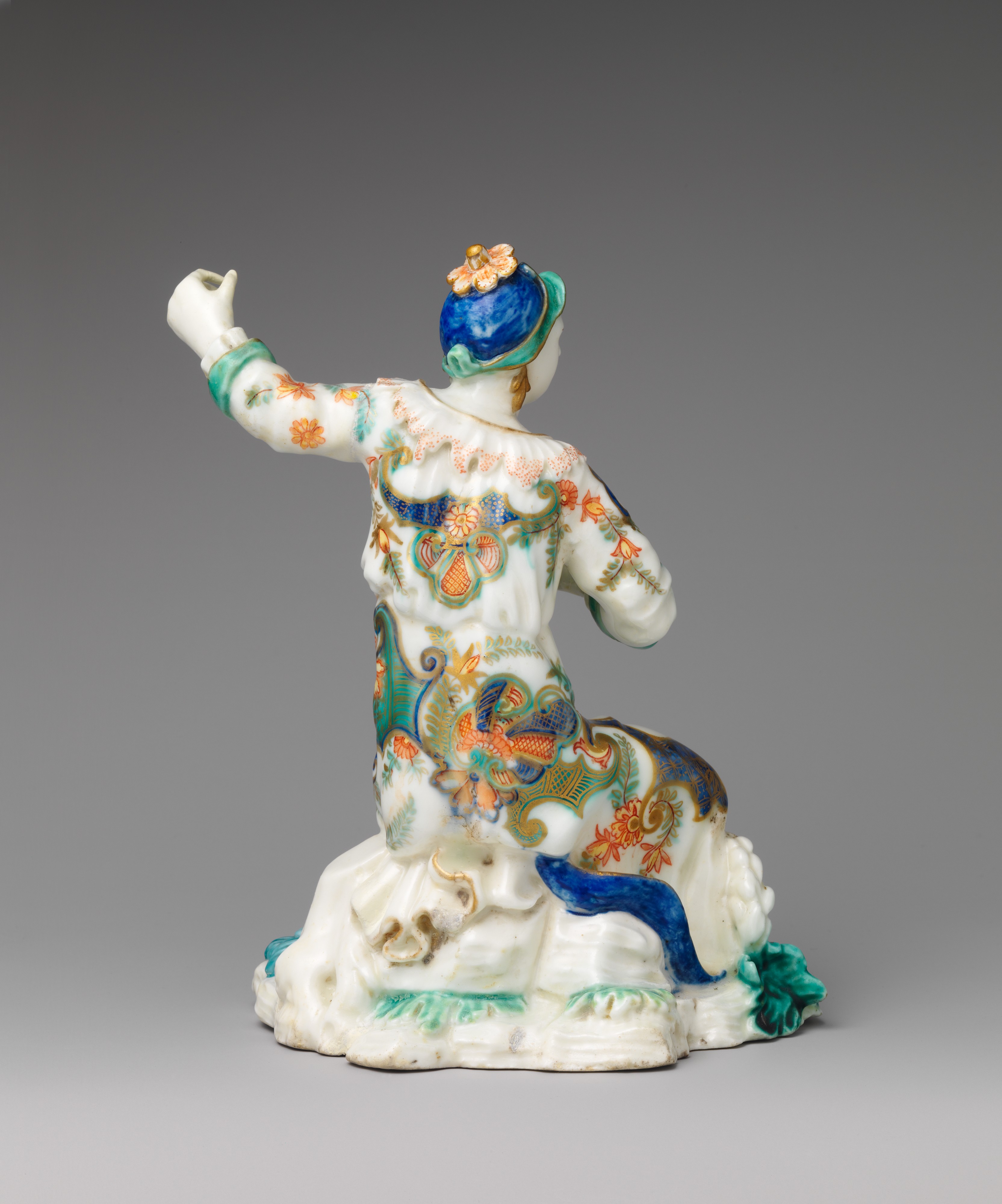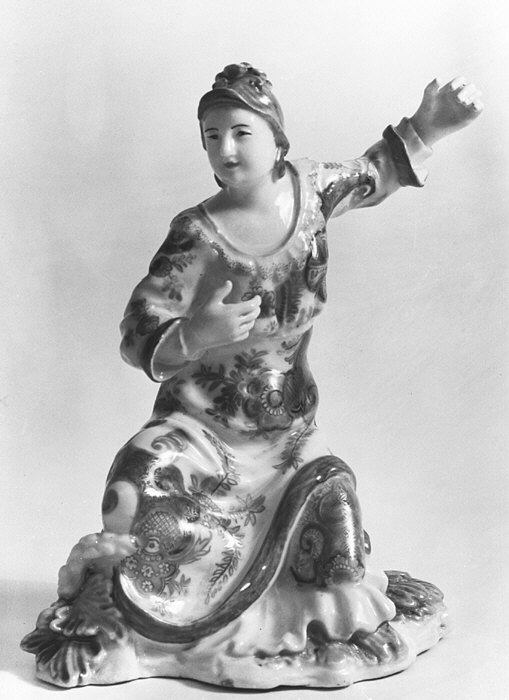Actress (one of a pair)
Factory Saint-Cloud factory French
Not on view
The production of the Saint-Cloud factory was focused primarily on utilitarian wares, although vases were made as well, especially in the first decades of the factory’s history (see 17.190.1911 and 17.190.1912a, b). Most of the factory’s production was small in scale, and items such as pomade pots, snuffboxes, knife handles, potpourris, and cups and saucers appear to have constituted a sizable percentage of the factory’s output. It would seem that porcelain sculpture tested the technical and artistic limits of the factory’s capabilities, and relatively little sculptural work was produced during the seven or eight decades of the factory’s history.
These two figures are among the most ambitious of the sculptures made at Saint-Cloud. While most Saint-Cloud figures are characterized by a certain static quality and an absence of finely modeled detail, these two figures convey a degree of expressiveness and a sense of movement, and their modeling is of greater complexity than is commonly found in Saint-Cloud sculpture. Both figures are distinguished by their gesturing arms, and they occupy a three-dimensional space more fully than most figures made at the factory.
It is probable that the two figures represent actors dressed as Chinese characters,[1] and thus the prominence of the figures’ gestures can be explained by their identity as theatrical subjects. The reading of the figures as being Chinese, however, is due primarily to the hat of the male figure and the bold patterning of the robes worn by both figures. His broad-brimmed, tall hat ending in a point is a variant on the type of hat that Europeans traditionally identified with male figures from the Far East, and his identity as a Chinese figure is enhanced by the prominent mustache and goatee that were often regarded in Europe as traditional attributes of both Chinese and Japanese men. The headdress worn by the female figure, however, is not one commonly associated with women from these countries but rather evokes a simplified version of the helmet type seen in depictions of the Greek goddess Athena. Her “Eastern” qualities seem to derive entirely from her patterned robe and by being paired with the more overtly Chinese male. The robes worn by both figures are not directly derived from Chinese or Japanese models but evoke a Far East design vocabulary in their motifs and in their palette, which is similar to that found on Japanese export porcelain.
Three other pairs of these figures are known. A second pair is also in the Museum (1982.60.253, 254),[2] the third pair is in the Musée des Arts Décoratifs, Paris,[3] and a fourth pair, present location unknown, was formerly in the Félix Doistau collection, Paris.[4] The two pairs in the Museum have polychrome decoration; the examples in the Musée des Arts Décoratifs and formerly in the Doistau collection have been left white. There are subtle differences between the four pairs in the modeling of the figures; most of the differences lie in the treatment of the rockwork and abstracted vegetation at the base,[5] but it is difficult to ascertain if the minor variations in this area and elsewhere in the figures are due to the finish work done by the modelers before the first firing, or if the molds were modified in the course of the production of these models.[6]
It has been suggested by Clare Le Corbeiller that the white porcelain figures produced in China in Dehua, Fujian province, during the early eighteenth century were the inspiration for the first figures produced at Saint-Cloud.[7] These early Saint-Cloud sculptures, which appear in the first three decades of the eighteenth century, depict Chinese figures and are characterized by simple modeling, minimal detail, and the absence of any painted decoration.[8] A second and different group of figures appears in the 1730s, to which the present examples belong. As noted above, these figures depict European actors wearing Chinese-inspired costumes, and the production of these figures may be due to the popularity in Paris of theatrical events with Chinese themes.[9] These slightly later figures are commonly modeled in more complex poses and with greater detail [10] than the earlier figures intended to depict Chinese men and women, albeit through the lens of the Saint-Cloud modelers.
It is probable that most of the Saint-Cloud figures of both categories were intended to be mounted in gilt bronze, sometimes serving as components of clocks or of candelabra, as in the case of the second pair at the Museum,[11] or simply fitted with gilt-bronze bases to enhance their status as decorative objects, as can be seen in the pair at the Musée des Arts Décoratifs.[12] It is likely that none of the figures were produced to decorate the dessert table, as this fashion did not take hold in Paris until the mid-1740s.[13] The present pair of figures can be regarded as among the earliest porcelain sculpture to have been produced in Europe. While a few figures were produced at the Meissen and at Du Paquier factories prior to 1735, it was only in the second half of the 1730s that either of these factories began figural production on a significant scale, and it was those made at Meissen in the late 1730s and 1740s that achieved huge popularity as table decoration throughout Europe. These Saint-Cloud figures of actors can thus be seen as one of the first ambitious attempts to initiate a sculptural tradition in what was then the new medium of porcelain.
Footnotes
(For key to shortened references see bibliography in Munger, European Porcelain in the Metropolitan Museum of Art. NY: The Metropolitan Museum of Art, 2018)
1 Clare Le Corbeiller proposed this description of the figures in Masterpieces of Fifty Centuries 1970, p. 280, no. 315, and again in an unpublished catalogue entry intended for publication in Rondot 1999a (curatorial files, Department of European Sculpture and Decorative Arts, The Metropolitan Museum of Art, New York). See also Le Corbeiller in Rondot 1999a, p. 293.
2 This pair is mounted in gilt bronze with porcelain flowers to form two three-branch candelabra; Le Corbeiller in Metropolitan Museum 1984a, p. 321, nos. 294, 295.
3 Bertrand Rondot in Rondot 1999a, p. 226, no. 172. Each of the figures sits on a gilt-bronze base.
4 See Galerie Georges Petit, Paris, sale cat., June 18–19, 1928, no. 65.
5 The most visible difference is that both Linsky figures have been modeled with a tree stump at the base, which is absent in the other three pairs.
6 This comparison was made using photographs of the Musée des Arts Décoratifs pair and of the pair formerly in the Doistau collection.
7 Le Corbeiller in Rondot 1999a, p. 293.
8 For example, see Rondot in ibid., p. 224, no. 170.
9 Le Corbeiller in ibid., p. 293.
10 Two other figures from this group were illustrated in the catalogue for the sale at Sotheby Parke Bernet, New York, December 5–7, 1974, no. 37.
11 See 1982.60.253, .254
12 See note 3.
13 Le Corbeiller in Roth and Le Corbeiller 2000, p. 30.
This image cannot be enlarged, viewed at full screen, or downloaded.
This artwork is meant to be viewed from right to left. Scroll left to view more.






